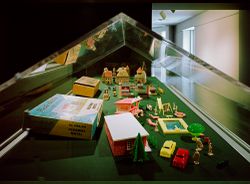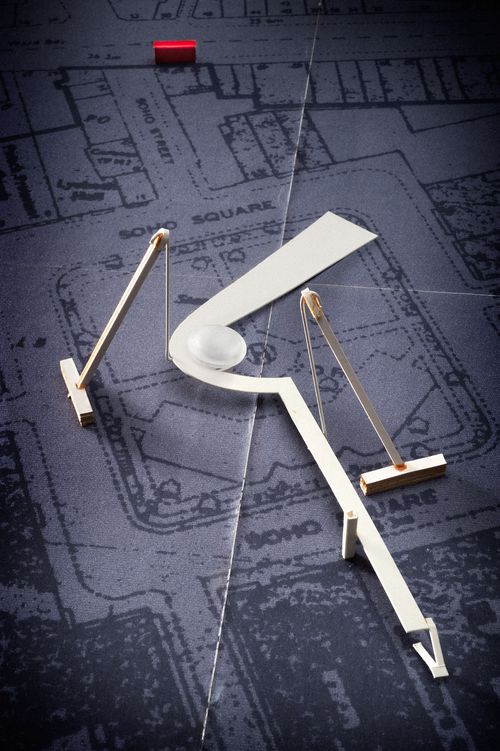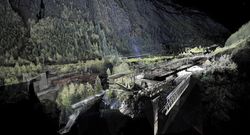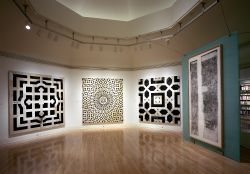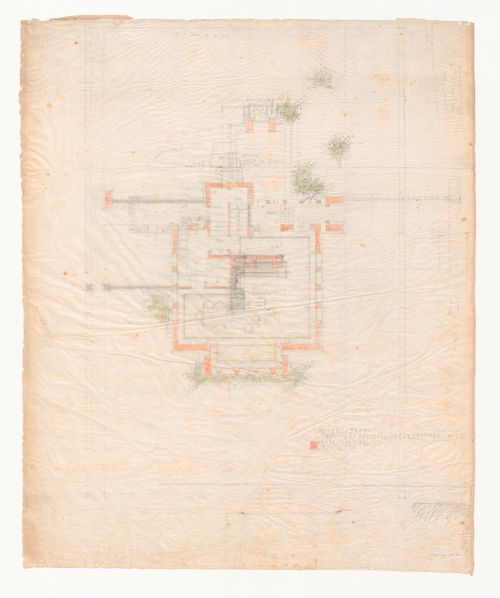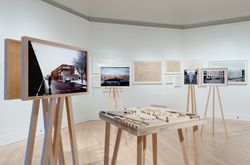Les jouets sont de précieux témoignages sur la vie sociale et économique d’une époque. De plus, des blocs de construction en bois aux jeux de construction en fer et en acier, ils reflètent des changements techniques et des styles d’architecture très en vogue à un certain moment. Par ailleurs, les principes des techniques nouvelles à l’origine des nouveaux bâtiments, ont(...)
Salle octogonale
28 novembre 1990 au 31 mars 1991
L'architecture en jeux : jeux de construction du CCA
Actions:
Description:
Les jouets sont de précieux témoignages sur la vie sociale et économique d’une époque. De plus, des blocs de construction en bois aux jeux de construction en fer et en acier, ils reflètent des changements techniques et des styles d’architecture très en vogue à un certain moment. Par ailleurs, les principes des techniques nouvelles à l’origine des nouveaux bâtiments, ont(...)
Salle octogonale
DR2004:0797
Description:
scaled site plan model of Magnet #2
1995-1996
Magnet: Presentation model for site #2, Soho Square, London
Actions:
DR2004:0797
Description:
scaled site plan model of Magnet #2
Lancé en novembre 1998 par la Fondation du Centre Canadien d’Architecture, le Prix du CCA pour la conception des villes invitait les architectes du monde entier à relever un défi qui se pose à toutes les grandes villes à l’aube du XXIe siècle : la revitalisation de secteurs urbains lacérés par d’importantes structures liées aux transports, vestiges de l’activité(...)
Salles principales
15 novembre 2000 au 1 avril 2001
New York : Concours CCA pour la conception des villes
Actions:
Description:
Lancé en novembre 1998 par la Fondation du Centre Canadien d’Architecture, le Prix du CCA pour la conception des villes invitait les architectes du monde entier à relever un défi qui se pose à toutes les grandes villes à l’aube du XXIe siècle : la revitalisation de secteurs urbains lacérés par d’importantes structures liées aux transports, vestiges de l’activité(...)
Salles principales
archives
Niveau de description archivistique:
Fonds
AP198
Résumé:
The Kivi Sotamaa OCEAN North project records, 1997-2000, consist of born-digital files, drawings, photographs, and physical models that document two projects by the OCEAN North collective: Jyväskylä Music and Arts Centre (competition, 1997) and Tölöö Football Stadium (competition, 1997). The archive also includes born-digital reference materials on 14 projects from the collective, including the two projects mentioned above.
1997-2000
Documents d’archives de Kivi Sotamaa pour les projets de OCEAN North
Actions:
AP198
Résumé:
The Kivi Sotamaa OCEAN North project records, 1997-2000, consist of born-digital files, drawings, photographs, and physical models that document two projects by the OCEAN North collective: Jyväskylä Music and Arts Centre (competition, 1997) and Tölöö Football Stadium (competition, 1997). The archive also includes born-digital reference materials on 14 projects from the collective, including the two projects mentioned above.
archives
Niveau de description archivistique:
Fonds
1997-2000
Dénouer le paysage numérique
Dans cette conférence, Christophe Girot aborde les modèles de paysage numérique : Le design et l’analyse du paysage numérique ont traversé une révolution tranquille au cours des dix dernières années, suscitée par l’introduction de modèles numériques de nuages de points. La portée et la précision de ces modèles de paysages numériques créés à l’aide de lecteurs laser(...)
Théâtre Paul-Desmarais
6 octobre 2016, 18h
Dénouer le paysage numérique
Actions:
Description:
Dans cette conférence, Christophe Girot aborde les modèles de paysage numérique : Le design et l’analyse du paysage numérique ont traversé une révolution tranquille au cours des dix dernières années, suscitée par l’introduction de modèles numériques de nuages de points. La portée et la précision de ces modèles de paysages numériques créés à l’aide de lecteurs laser(...)
Théâtre Paul-Desmarais
L’exposition présente la quête de l’architecte américain Ben Nicholson pour l’ordre, le sens et la logique dans un monde où se mêlent art, science et mystère. La bibliothèque Laurentienne de Florence, un chef-d’œuvre conçu par Michel-Ange en 1524-1525, possède quinze paires de panneaux de terre cuite ornés de motifs géométriques complexes, panneaux qui furent longtemps(...)
Salle octogonale
11 décembre 1996 au 9 mars 1997
Découvrir la géométrie : Ben Nicholson et la bibliothèque Laurentienne
Actions:
Description:
L’exposition présente la quête de l’architecte américain Ben Nicholson pour l’ordre, le sens et la logique dans un monde où se mêlent art, science et mystère. La bibliothèque Laurentienne de Florence, un chef-d’œuvre conçu par Michel-Ange en 1524-1525, possède quinze paires de panneaux de terre cuite ornés de motifs géométriques complexes, panneaux qui furent longtemps(...)
Salle octogonale
Projet
University Art Museum
AP143.S4.D65
Description:
File documents the unexecuted project for the University Art Museum, Long Beach, California. Material in this file was produced between 1986 and 1988. California State University, Long Beach (CSULB), commissioned Eisenman/Robertson Architects to design an art museum adjacent to the main campus entrance. The 67,500-square-foot building was to comprise four galleries, a black-box theater, an auditorium, a cafe, conference rooms, a library, offices, preparation spaces, and storage vaults. The project, sited on a 23-acre arboretum, included landscaping; terraced sculpture courtyards, botanical gardens, and a two-acre pond. Eisenman linked the northern and southern parts of the arboretum by an elevated public walkway through the museum. Sets of drawings were presented on 8 and 30 April, 2 June, and 5 Aug. In the first design phase Eisenman explores the cartographic figures which form the basis of his artificial excavation when superposed: a series of sketches establishes the analogical relationships which fix the relative scales of the plans and produce the superpositions; another series contextualizes the superposed figures by placing them within the museum site (DR1987:0859:087-090). The second phase concerns the building; the working model shows the building carved out of a square pit, from which spring an oil derrick and a reconstruction of a recreational pier (Rainbow Pier, 1920s) used here as circulatory bridge (DR1987:0859:160). In the third phase the architect systematizes his archeological procedure by using five significant cartographic dates - 1849, 1889, 1949, 1989, 2049 - each corresponding to a specific superposition (see DR1987:0859:274-277). In the fourth phase, Eisenman simplifies the superposition of 2049 to a few iconic colour-coded forms: ranch (green), ranch house (blue), campus site (red), and water forms (river and pond) (gold). Material for the fourth phase includes three relief models, four presentation drawings, and a model (property of the CSULB) (relief models: DR1987:0859:001-003; drawings: DR1987:0859:004-008). Eisenman "inhabits" his artifical archeology by detailed planning of interior spaces, and gives substance to the cartographic traces in a series of sketch sections, perspectives, and working models. Working models reveal how the central "canal" area gradually became the museum's access point (DR1987:0859:484-490); the museum, galleries, offices, and preparation areas are on one side of this deep cut, while the cafeteria and black-box theater are on the other. The upper level was to house offices, meeting rooms, and the library. File contains audiovisual material, conceptual drawings, design development drawings, presentation drawings, reference drawings, working drawings, photographic materials, and textual records.
1986-1988
University Art Museum
Actions:
AP143.S4.D65
Description:
File documents the unexecuted project for the University Art Museum, Long Beach, California. Material in this file was produced between 1986 and 1988. California State University, Long Beach (CSULB), commissioned Eisenman/Robertson Architects to design an art museum adjacent to the main campus entrance. The 67,500-square-foot building was to comprise four galleries, a black-box theater, an auditorium, a cafe, conference rooms, a library, offices, preparation spaces, and storage vaults. The project, sited on a 23-acre arboretum, included landscaping; terraced sculpture courtyards, botanical gardens, and a two-acre pond. Eisenman linked the northern and southern parts of the arboretum by an elevated public walkway through the museum. Sets of drawings were presented on 8 and 30 April, 2 June, and 5 Aug. In the first design phase Eisenman explores the cartographic figures which form the basis of his artificial excavation when superposed: a series of sketches establishes the analogical relationships which fix the relative scales of the plans and produce the superpositions; another series contextualizes the superposed figures by placing them within the museum site (DR1987:0859:087-090). The second phase concerns the building; the working model shows the building carved out of a square pit, from which spring an oil derrick and a reconstruction of a recreational pier (Rainbow Pier, 1920s) used here as circulatory bridge (DR1987:0859:160). In the third phase the architect systematizes his archeological procedure by using five significant cartographic dates - 1849, 1889, 1949, 1989, 2049 - each corresponding to a specific superposition (see DR1987:0859:274-277). In the fourth phase, Eisenman simplifies the superposition of 2049 to a few iconic colour-coded forms: ranch (green), ranch house (blue), campus site (red), and water forms (river and pond) (gold). Material for the fourth phase includes three relief models, four presentation drawings, and a model (property of the CSULB) (relief models: DR1987:0859:001-003; drawings: DR1987:0859:004-008). Eisenman "inhabits" his artifical archeology by detailed planning of interior spaces, and gives substance to the cartographic traces in a series of sketch sections, perspectives, and working models. Working models reveal how the central "canal" area gradually became the museum's access point (DR1987:0859:484-490); the museum, galleries, offices, and preparation areas are on one side of this deep cut, while the cafeteria and black-box theater are on the other. The upper level was to house offices, meeting rooms, and the library. File contains audiovisual material, conceptual drawings, design development drawings, presentation drawings, reference drawings, working drawings, photographic materials, and textual records.
File 65
1986-1988
DR1980:0060:002
Description:
- This first floor plan, with the perspective (DR1980:0060:001) and the second floor plan (DR1980:0060:003) form a set of early presentation drawings. The scale is probably 1/4" = 1' (see object file, de Long report). This plan indicates reworking in the porch/stair and service entrance areas which appear in Hitchcock's book (plate 201) and were built as sketched. The fireplace and seat in the living room were shifted and subsequently built as sketched, as was the ice room. The wall added to the right was shifted back in the final Hitchcock plan. The entry behind the livingroom has sketched-in doors at the rear, as seen in the Hitchcock drawing -- other doors do not yet appear, nor does the garden court. The house became more private in the final adjustments to the site. Wright's further changes are: the wall extending left was crossed out; a freehand wall is roughed in to right; heavy masonry walls are roughed in to left over former wall. (There are other miscellaneous markings and crosshatchings in the reworking.)
architecture
1915
First floor plan for Emil Bach House, Chicago, Illinois
Actions:
DR1980:0060:002
Description:
- This first floor plan, with the perspective (DR1980:0060:001) and the second floor plan (DR1980:0060:003) form a set of early presentation drawings. The scale is probably 1/4" = 1' (see object file, de Long report). This plan indicates reworking in the porch/stair and service entrance areas which appear in Hitchcock's book (plate 201) and were built as sketched. The fireplace and seat in the living room were shifted and subsequently built as sketched, as was the ice room. The wall added to the right was shifted back in the final Hitchcock plan. The entry behind the livingroom has sketched-in doors at the rear, as seen in the Hitchcock drawing -- other doors do not yet appear, nor does the garden court. The house became more private in the final adjustments to the site. Wright's further changes are: the wall extending left was crossed out; a freehand wall is roughed in to right; heavy masonry walls are roughed in to left over former wall. (There are other miscellaneous markings and crosshatchings in the reworking.)
architecture
« Wohnhaus Schlesisches Tor » (aussi appelé « Bonjour Tristesse ») à Berlin et « Punt en Komma » à La Haye sont les premiers ouvrages d’Álvaro Siza construits hors du Portugal, sa terre natale. Ils ont en commun leur taille, envergure, vocation et ambition ; tous deux ont été érigés dans les années 80, tous deux découlent d’une perception particulière de la ville et tous(...)
Salle octogonale Mot(s)-clé(s):
Álvaro Siza, Punt en Komma, The Hague, Bonjour Tristesse, Berlin
24 septembre 2015 au 22 mai 2016
Coin, îlot, quartier, villes. Álvaro Siza à Berlin et à La Haye
Actions:
Description:
« Wohnhaus Schlesisches Tor » (aussi appelé « Bonjour Tristesse ») à Berlin et « Punt en Komma » à La Haye sont les premiers ouvrages d’Álvaro Siza construits hors du Portugal, sa terre natale. Ils ont en commun leur taille, envergure, vocation et ambition ; tous deux ont été érigés dans les années 80, tous deux découlent d’une perception particulière de la ville et tous(...)
Salle octogonale Mot(s)-clé(s):
Álvaro Siza, Punt en Komma, The Hague, Bonjour Tristesse, Berlin
archives
Niveau de description archivistique:
Fonds
Fonds Gene Summers
AP114
Résumé:
The Gene Summers fonds documents primarily the later part of Gene Summers' career as an architect, developer, artist and art collector. Summer's early work with the Office of Mies van der Rohe and C.F. Murphy Associates is summarily represented by notes, sketches and photographs.
1957 - 2004
Fonds Gene Summers
Actions:
AP114
Résumé:
The Gene Summers fonds documents primarily the later part of Gene Summers' career as an architect, developer, artist and art collector. Summer's early work with the Office of Mies van der Rohe and C.F. Murphy Associates is summarily represented by notes, sketches and photographs.
archives
Niveau de description archivistique:
Fonds
1957 - 2004
